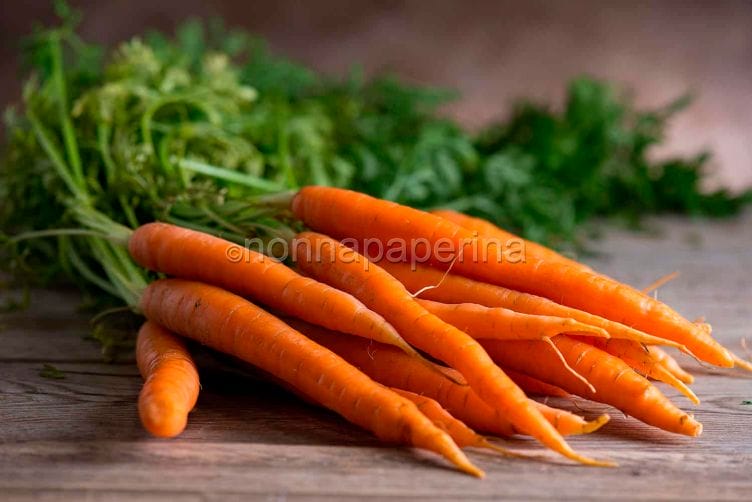Carrots

Carrots and their excellent nutritional properties
One of the most popular veggies is carrots. Their flavour, which is moderately sweet, as well as their adaptability and accessibility, deserve recognition. There are other varieties, but the orange one is the most common (I will discuss this in the paragraph that follows). The “Daucus carota” plant, which is a member of the Apiaceae family, is actually the root of the carrot. It is distinguished by tiny, fragrant white flowers and a strong green stem. In addition to being grown twice a year, carrots are also available in the summer.
Carrots are a concentrated source of nutrients; they are high in vitamin C and vitamin A, both of which are beneficial to the eyes. It’s important to recognise magnesium, calcium, phosphorus, and potassium among the mineral salts. In addition to these benefits, there is a very low caloric intake, which does not go beyond 35 kcal per 100 grammes.
The different varieties of carrots
There are numerous varieties of carrots. All are distinguished by colour, and some by their shape too. Here is a quick overview of the most common types of carrots:
- Orange: It is the classic, most widespread carrot, although it is one of the most recent. The flavour is basically sweet, and the dimensions can vary greatly. It has the highest amount of vitamin A and beta-carotene.
- Red: Its main characteristic is the presence of lutein and lycopene, two antioxidant substances that help fight free radicals.
- Yellow: It is identical in colour and shape to the orange ones; it is generally just a little smaller. It is grown in a restricted area near Polignano a Mare.
- White: It is similar in shape and colour to turnips. They are less sweet than the average carrot.
- Purple: It is the first “real” carrot, i.e., the oldest variety. It is characterised by the concentration of anthocyanins, which are powerful antioxidants.
- Black: Similar to purple carrots in flavour and the presence of anthocyanins, it has a more intense flavour and is generally larger.
How they are used in the kitchen
They are among the most versatile vegetables of all. They can be consumed raw, almost as if they were a snack, but they are also used to prepare juices, purees, and creams of all kinds. They are one of the classic sautéing ingredients and the basis for many recipes, as well as the protagonists and supporting elements of many others.
Among these delicious recipes, gnocchi stands out: carrot cream with heavy cream and almonds, soup, and gnocchi with pesto.
Carrots are a precious vegetable. Regardless of the taste, which you may or may not like (but it’s generally liked), they have notable nutritional characteristics. The reference is to the intake of vitamins, which is extraordinary. Carrots contain large quantities of vitamin C (which strengthens the immune system), B, E, and, above all, vitamin A. The partially genuine notion that carrots are beneficial for eyesight has been fueled by the extremely high presence of vitamin A. Mineral salts, including potassium, phosphorus, calcium, magnesium, selenium, iron, zinc, and copper, are also abundant in this vegetable.
The presence of the incredibly fascinating compound beta-carotene is another essential quality of carrots. The precursor of vitamin A, beta-carotene, has antioxidant properties and can promote the proliferation of cells. It functions as a balancing agent on the intestinal systems, produces a purifying effect, lowers bad cholesterol, protects the eyes, and helps avoid acute digestive system disorders like colitis when combined with lutein and zeaxanthin.
Here are a few carrot-based recipes
We know we always hit the target with the purple carrot cream with almonds and heavy cream! Are you searching for a comforting, filling, nourishing, and healthy first course? With the arrival of the first cold weather, seasonal ailments, and increasingly shorter days, the period of creams, broths, and veloutés begins! Nothing is better to face the long winter than a nice, steaming hot dish!
It’s true, we must admit, that the colour of the purple carrots doesn’t look very inviting, but don’t be fooled by appearances! With a little creativity, you can have fun plating this cream, playing with the colour notes of the sour cream, almonds, and fresh marjoram leaves. You can prepare some toast, perhaps, and some tasty bruschetta to accompany them. When you experience a first course like this, all doubts vanish as the elements appear to harmonise in a delightful symphony.
Carrot flan: economical and healthy cooking. The starters ought to be visually appealing and of high quality. I believe it is essential to start a dinner in the right spirit, which means not only presenting a healthy and tasty appetiser but also an aesthetically pleasing one.
Carrot flan is a great substitute because of its major ingredient’s vibrant colour, which makes it both healthy and interesting. When I have leftover carrots from a dip, I love to make this dish because it’s so easy and delicious. By doing this, I can prevent food waste and present a versatile option that can be used for anything, from appetisers to accompanying meat dishes.
The relationship between carrots and the intestine
We have seen the many nutritional properties of carrots. Now it is worth delving deeper into an aspect that is often the subject of some misunderstandings: the relationship between carrots and the intestine. Do carrots benefit the intestine, or are they responsible for risks to its health, perhaps following excessive consumption?
Carrots are beneficial to the intestines in general. The problem is more with vitamin A than with high fibre content; however, the fibre content still matters. Actually, this priceless ingredient has a protective effect on the intestinal mucosa in addition to aiding with vision. It decides on a more effective reaction to germs and viruses in light of this. Moreover, it serves as a barrier against reflux and colitis.
But carrots also benefit another fundamental organ: the liver. By virtue of the presence of some specific molecules, these precious vegetables support the liver in its purifying activity, preventing a possible “overload”.
Furthermore, carrots are also good for the vascular system as they help keep bad cholesterol under control, which causes acute and often fatal heart problems.
Varieties of carrots and their different benefits
If you want to honour carrots as a health food, you need to make a distinction between the different varieties. As we have seen, the varieties of carrots are numerous, as they differ mainly in colour. In reality, it is precisely the colour that reveals the presence of certain substances, which generate an extremely varied impact on the vegetable.
For example, classic orange carrots are rich in beta-carotene, which generates this colour and is also present in oranges and pumpkins. Beta-carotene is an excellent antioxidant and a precursor of vitamin A.
Purple carrots, on the other hand, are rich in anthocyanins, which are also present in radicchio and aubergines. Anthocyanins, as antioxidants, help prevent cancer and slow down ageing.
Finally, white carrots are rich in particular substances. The reference is to vitamin K, which promotes correct blood density and helps prevent thrombotic syndromes. The same goes for magnesium, phosphorus, and zinc, which support the body’s cognitive activities and energy levels.
Contraindications and clarifications regarding carrots
What are the contraindications to carrots? This issue is posed by those who have specific diseases or who are concerned about the potential consequences of consuming this vegetable in an “excessive” manner. Carrots actually don’t have any serious contraindications; in fact, paediatricians advise including them in the diet even for young children. Moreover, by virtue of their flavour, they represent the perfect food for weaning.
Obviously, you need to pay attention to the quantities. Excessive consumption, over half a kilo per day, could cause the onset of carotenosis. It is an “excess beta-carotene” syndrome that leads to some disorders: the skin takes on a yellowish hue in the palms of the hands and soles of the feet.
Additionally, carotenosis shows up as a kidney overload, which is not harmful to health. It is, after all, a completely curable condition with no special risks. Basically, all it takes to achieve complete remission is to temporarily remove carrots from your diet.



















